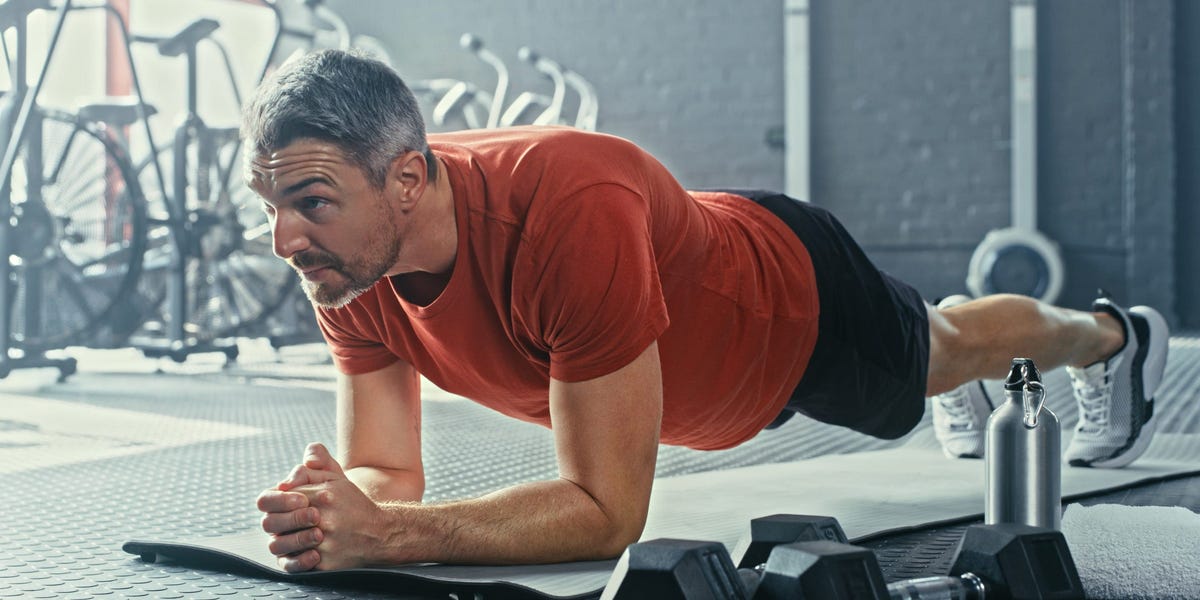- Picking the right type of workouts can help you live a longer, healthier life, a doctor says.
- Longevity expert Dr. Peter Attia said he does four types of workout to stay fit as he ages.
- His “four pillars” of fitness are strength, stability, steady cardio, and high intensity exercise.
When Dr. Peter Attia hits the gym, he’s not just thinking ahead to his next set of deadlifts or round of biking, but to the next 50 years. strategizing every rep to help him live to 100 and stay as strong as possible while doing so.
Attia, 50, is a longevity specialist training for the “Centenarian Decathlon,” prioritizing exercises which aim to maintain healthy, functional movement for key activities of living as an older adult, he said on his podcast The Drive.
The events in your personal Centenarian Decathlon can vary based on your unique goals and preferences. For Attia, these include getting up from the ground unassisted, squatting and bending over without injury, and lifting moderate weights up and overhead.
Attia has previously shared his workout routine on one podcast episode — which includes a combination of strength training, cardio, and stability exercises — for about 10 hours a week.
But a total beginner to exercise could benefit from even less, getting healthier with just over three hours a week of exercise, he said on more recent episode of his podcast. A good start would be to do an hour of low intensity cardio, an hour of strength training, and 30 minutes of high intensity cardio training, split between two sessions, and 10 minutes of stability every day.
By prioritizing four different types or “pillars” of movement, Attia recommends simple ways to exercise not just a long life, but living it to the fullest for decades to come.
Strength is a foundation for living a long, healthy life
Resistance training, including weight lifting, is an essential part of Attia’s longevity plan, and makes up about 50% of the workouts.
That’s because strength consistently shows up in practical applications of daily life: his examples include holding a child, carrying groceries, or lifting a suitcase into an overhead compartment.
Compound exercises like deadlifts, squats, shoulder presses, and farmer carries work multiple muscle groups at once, and are similar to movement patterns you’ll use in everyday life.
You can also strength train without weights by using bodyweight movements like pull-ups, push-ups, and lunges.
Research backs up the benefits of strength training as we age, too. A 2022 study found that a combination of strength training and cardio can help you live longer.
Stability can help prevent injury as we age
Another key factor in staying physically vibrant as we age is stability, being able to control your body
Attia’s examples of stability-related goals include being able to get up from the ground using one arm or holding a one minute plank.
Another goal, and also a good test of stability Attia recommends, is to balance on one leg — research suggests how well you can do this, and for how long, can be a good indication of your overall health.
To accomplish this, Attia has previously said on his podcast that he spends about 10 minutes at the beginning of each workout on stability exercises like step-ups.
Many exercises also help improve stability and strength at the same time, such as weighted movements like a goblet squat that promote a solid core and good posture.
Low-intensity cardio can boost heart health
While strength training is necessary for healthy muscle, it’s equally important to do aerobic or cardio exercise for a healthy heart and lungs, according to Attia.
But you don’t need to go all-out for every cardio workout. In fact, low-intensity cardio has major benefits for health and longevity, sports medicine doctor and triathlete Morgan Busko previously told Insider.
Slow, steady aerobic exercise can help keep your heart (and the rest of you) healthy because it promotes the growth of mitochondria, which provide power to the cells.
Over time, it can make your body more efficient at using energy, improving your stamina and ability to handle physical strain, Busko said.
Small doses of intense exercise can boost your lifespan
Attia also recommends doing some workouts at a higher intensity. Everyday examples include climbing multiple flights of stairs, or rucking, one of Attia’s go-to exercises that involves carrying a weighted backpack.
One measure of your ability to do intense cardio is VO2 max, or peak ability to use oxygen during exercise. Maintaining a good VO2 max can reduce health risks and also help you keep up with daily habits and hobbies you love as you get older, Attia said in his podcast.
“If you can do that, that basically buys you a bunch of activities,” he said.
But don’t be daunted by the prospect of all the different types of exercise if you’re older and aren’t (yet) athletic — Attia said it’s never too late to start doing something.
“I would never want anybody to come away from this thinking, ‘I’m too old to do anything about it.’ I think as long as you’re breathing, you have a chance to do something about it,” he said.







